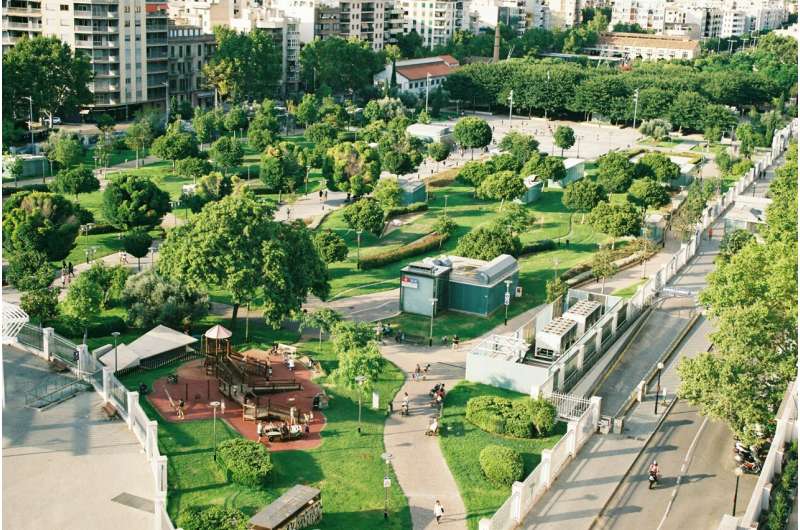This article has been reviewed according to Science X's editorial process and policies. Editors have highlighted the following attributes while ensuring the content's credibility:
fact-checked
peer-reviewed publication
trusted source
proofread
Impact of neighborhood resources on resilience after trauma: Q&A

McLean researchers sought to examine whether neighborhood and individual resources prospectively predicted PTSD trajectories following a recent trauma. They found significant interaction between individual and neighborhood resources: Individuals with high self-reported individual resources who were exposed to more greenspace had a greater likelihood of experiencing little to no symptoms of PTSD following a trauma.
E. Kate Webb, Ph.D., a research fellow at McLean Hospital who works in the Neurobiology of Fear Laboratory and Neurobiology of Affective and Traumatic Experiences Laboratory, led an investigation into whether individual resources and neighborhood resources, like greenspace, might impact neurobiology and the trajectory of posttraumatic stress disorder (PTSD) symptoms.
Her research was published July 31st in JAMA Psychiatry.
What led you to examine the link between neighborhood characteristics and PTSD?
About 46 million people experience a traumatic event each year that is significant enough to require medical attention, and about 10 to 20% of those individuals will develop symptoms indicative of PTSD.
Research trying to predict who is at-risk for developing PTSD has often focused on individual-level factors, such as age or past trauma history.
This body of research has largely overlooked influential neighborhood-level factors that may help mitigate the development of PTSD. That is a major gap, as we have learned that where someone lives can greatly impact mental health. For example, previous studies have found that living in a neighborhood with more access to greenspace is associated with lower levels of stress, anxiety and depression, regardless of socioeconomic status.
Our primary objective was to examine whether neighborhood and individual resources prospectively predicted PTSD trajectories following a recent trauma.
How did you conduct this study?
As part of the largest longitudinal, multisite study of adverse post-trauma outcomes of its kind (The AURORA Study), nearly 2,600 individuals were recruited from emergency departments across the United States within 72 hours of a trauma.
We examined this robust dataset closely and calculated new neighborhood factors. We geocoded participants' home addresses and derived their exposure to greenspace from high-resolution satellite imagery as well as their neighborhood's socioeconomic status.
Our first objective was to determine whether self-reported individual (e.g ability to cope with adversity) and neighborhood resources (greenspace) predicted an individual's assignment to a specific PTSD trajectory, such as whether they had no, low or high symptoms over time. As a secondary objective, we examined relationships to these resources with neural activity gleaned from brain imaging the participants underwent.
What were your main findings?
We first identified a significant interaction between individual and neighborhood resources, such that individuals with high self-reported individual resources who were exposed to more greenspace had a greater likelihood of being assigned to a resilient trajectory; they experienced low or no symptoms over time.
We did not find that greenspace alone affected PTSD trajectories, which suggests neighborhood-level greenspace works in conjunction with individual factors to protect against posttraumatic dysfunction.
We separately found that greenspace was associated with greater neural reactivity within the amygdala, a region of the brain involved in detecting and updating the value of rewarding cues. This finding, taken with previous studies, suggests greenspace may help replenish cognitive resources required to identify stimuli as rewarding.
We, however, did not find a direct association with amygdala reactivity and PTSD trajectories. Additional work should examine other posttraumatic outcomes that may be related to reward reactivity, such anhedonia (lack of pleasure or motivation).
What next steps can build off this new research?
The inclusion of socioenvironmental factors such as neighborhood disadvantage and greenspace represents an exciting paradigm shift in psychiatry, but PTSD studies have predominately concentrated on risk factors.
Although risk models are useful in pinpointing the types of adversity and inequities that contribute most to PTSD development, the type of resilience model employed in our study may offer an opportunity to identify where to invest critical financial and cultural resources to maximize treatment and intervention efficacy.
We believe this work highlights that examining factors at individual and neighborhood levels may improve the early identification of individuals at-risk for developing PTSD after trauma, which could then facilitate earlier delivery of effective treatments.
More information: Webb et al. Neighborhood Resources Associated With Psychological Trajectories and Neural Reactivity to Reward After Trauma, JAMA Psychiatry (2024). DOI: 10.1001/jamapsychiatry.2024.2148


















